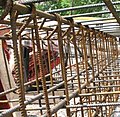Reinforcement

Reinforcement or reinforcement refers to the reinforcement of concrete components to increase the load-bearing capacity. It is a composite material .
The best-known application is the reinforcement steel cast in reinforced concrete . The embedding of geotextiles in earthworks for the production of reinforced earth is also gaining in importance. Further applications are, for example, plastic reinforced with glass or carbon fibers (GRP, CFRP).
The reinforcement increases the resistance of the material to tensile stress . However, it can also be used to change other material properties in the desired manner, such as the impact , flexural and compressive strength, or the ductility, i.e. the plastic deformation capacity. In contrast to an isotropic material (the same in all directions), materials can be made anisotropic by inserting a reinforcement. H. the reinforcements or resistors are installed where they are needed.
history
The terms reinforcement or reinforcement originally come from military technology ; Armament (French armement ) in the sense of a strengthening of the ability to defend z. B. a fortification .
Reinforcements in construction
Concrete is relatively pressure-resistant, but cracks when subjected to tensile stress. It is therefore reinforced by structural steel ( reinforcing steel or reinforcing steel ), as well as in individual cases by glass fibers (AR glass made from alkali-resistant fibers) or carbon fibers (carbon), which are able to absorb the tensile forces. The resulting composite material is referred to as reinforced concrete or textile concrete .
Before laying the reinforcement is a reinforcement plan created. Prefabricated welded wire mesh can absorb tensile forces in two directions and make laying easier. The reinforcement can be arranged to absorb tensile forces (mostly from bending or bending) or compressive forces (e.g. in highly loaded columns). If the concrete is prestressed by means of prestressed reinforcement, it is called prestressed concrete .
The use of GRP reinforcement bars and fiberglass or synthetic fiber fabrics is currently limited to special applications, as is the addition of short steel, plastic or glass fibers in the manufacture of fiber concrete . Connections to existing reinforced concrete components through subsequently mortared reinforcement bars are referred to as reinforcement connections. A secure connection is achieved through the use of high-strength composite mortar.
In tunnel construction , among other things, shotcrete (for example with the New Austrian Tunneling Method ) and anchors are used, in earthworks , on slippery slopes or for environmental protection, various geotextiles are used . See also: Reinforced Earth
In buildings, wall and ceiling plaster is reinforced in critical areas by inserting jute or plastic fabric mats or expanded metal mesh. The reinforcement reduces the formation of cracks in the plaster, which is particularly important for thermal insulation composite systems. Rabitz grid is used in the creation of Rabitz as a plaster base and reinforcement.
Screed is occasionally reinforced to avoid cracks, especially if it is made in thin layers or is on top of insulation. Simple steel grids or synthetic fabrics are used, and recently also interspersed, short fibers made of steel , glass fibers or plastic . See also: glass fiber reinforced plastic and fiber cement
Reinforcement in mechanical engineering
In foundry technology , heavily loaded cores are reinforced with core irons .
Wood, metal (e.g. aluminum ) or plastic parts are covered with glass or carbon fiber strands or mats and soaked with synthetic resin (e.g. epoxy resin ) to solidify them . The field of application ranges from boat building to space travel .
See also
Picture gallery
Reinforced concrete bridge piers of the Brno Viaduct
Reinforcement for bored pile tunnel Garmischer Strasse





